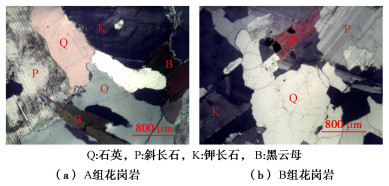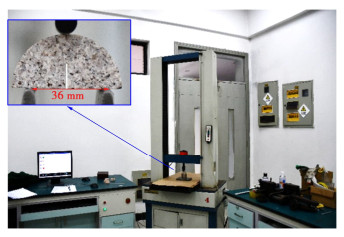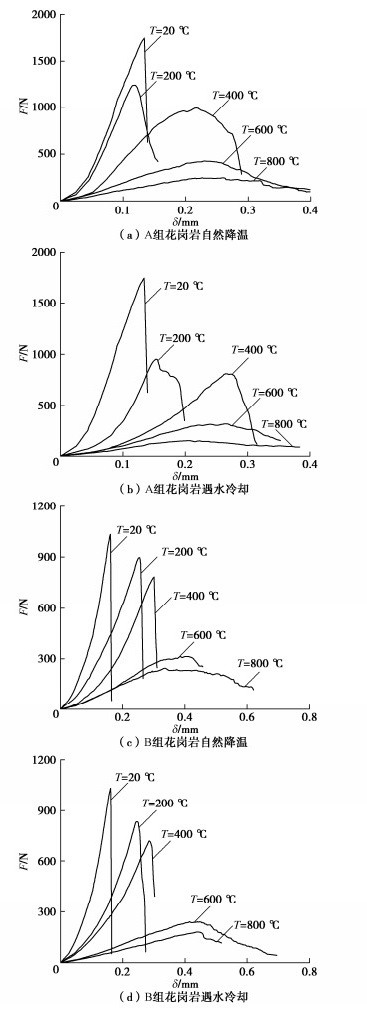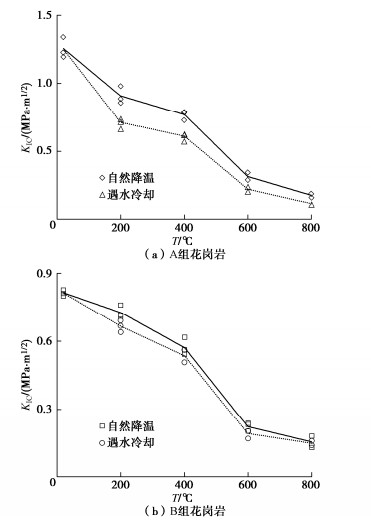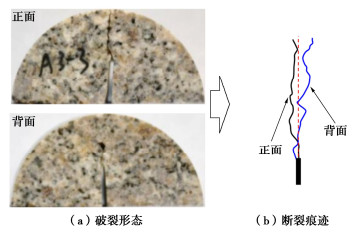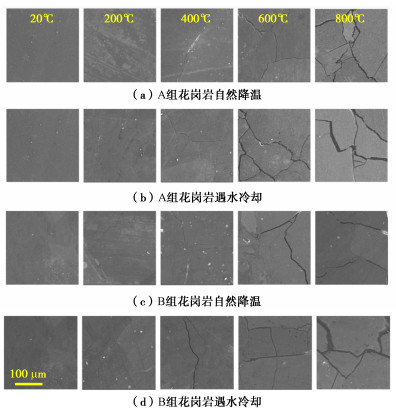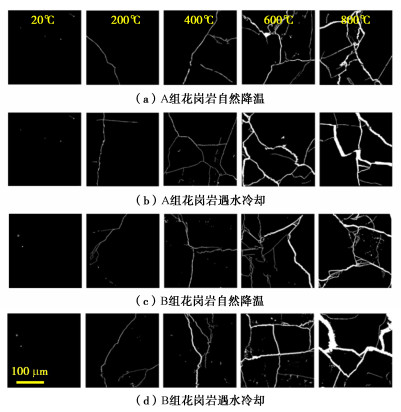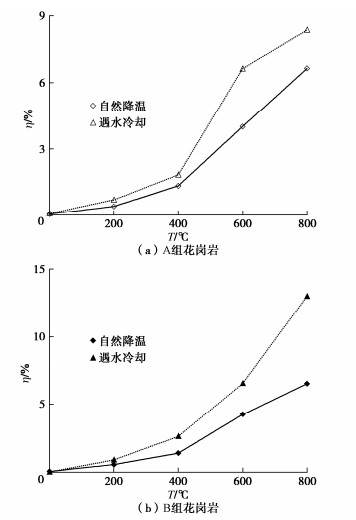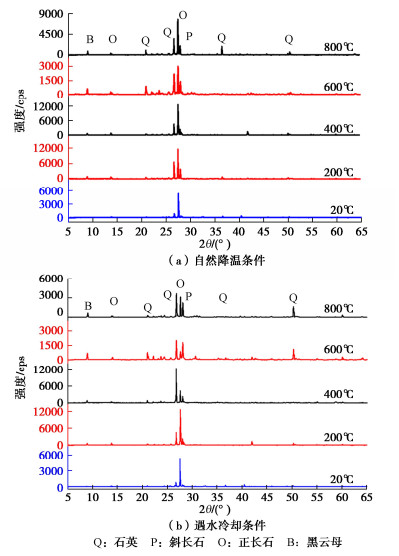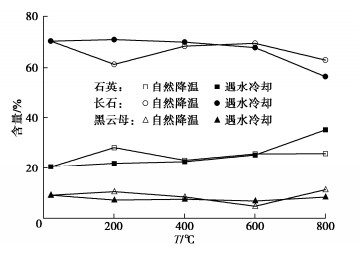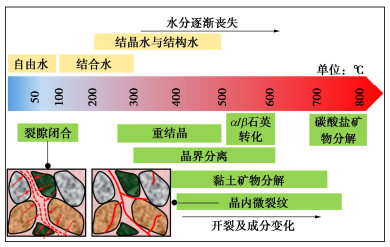Fracture behavior and thermal cracking evolution law of granite specimens after high-temperature treatment
-
摘要: 在深部地热能开发中高温岩体会经历不同速率降温过程,研究高温作用后岩石力学行为对深部地下工程具有重要意义。然而,不同冷却方式下高温花岗岩断裂特性演化规律及作用机制尚不明晰。基于此,进行了不同冷却方式下花岗岩半圆盘试样三点弯曲试验,分析了高温后花岗岩荷载-位移曲线、断裂韧度以及破裂特征,探讨了微裂纹分布及矿物含量演化规律。试验结果表明:①随着温度的升高,花岗岩断裂韧度呈减小趋势,遇水冷却方式下断裂韧度低于自然降温条件;②三点弯曲作用下花岗岩半圆盘试样裂纹首先萌生于切槽尖端,逐渐向加载点方向扩展并将岩样劈裂。随着温度的升高,花岗岩试样的断裂痕迹曲折程度、与中心线之间的距离有所增大;③随着温度的升高,花岗岩矿物成分未明显变化,基于图像处理技术获得的微裂纹密度逐渐上升,遇水冷却方式下微裂纹密度大于自然降温方式,表明高温引起的微观结构劣化降低了花岗岩断裂韧度。Abstract: During the exploitation of deep geothermal energy, the thermal rocks will cool with different cooling rates. A comprehensive understanding of mechanical behavior of the thermal-treated rock is very important for deep underground engineering. However, the fracture behavior and influence mechanism of thermal granite specimens under different cooling ways are unclear at present. Therefore, in this study, the three-point bedding tests are carried out on the semicircular bend granite specimens after high-temperature treatment. The load-displacement curves, fracture toughnesses and failure patterns of the post-heated granite specimens are analyzed, and the evolution laws of micro-cracks and mineral components are discussed. The experimental results show that: (1) As the temperature increases, the fracture toughness of the granite specimens decreases. The fracture toughness of the specimens after quenching in water is lower than that after cooling down naturally in the furnace. (2) The crack initiated from the tip of notch propagates toward the loading point and splits the specimen into two parts. As the temperature increases, the tortuosity degree and deviation of fracture trace of the semicircular bend granite specimens increase. (3) The mineral components of granite are not significantly changed after high-temperature treatment. The micro-crack rate identified by the image processing increases with the increase of high temperature, and that of the specimen after quenching in water is higher than that after cooling down naturally in the furnace, which indicates that the deterioration of micro-structure of rock induced by high-temperature treatment reduces the fracture toughness of granite.
-
Keywords:
- rock mechanics /
- granite /
- high temperature /
- fracture toughness /
- image processing
-
0. 引言
预应力锚固技术具有对岩(土)体扰动小,施工快捷,安全可靠,经济高效等优点,已成为高边坡、大跨度地下洞室以及深基坑等重要岩体结构的首选支护处理手段,预应力锚固技术应用越来越普遍[1-3]。如在长江三峡水利枢纽船闸高边坡加固工程中,共使用了1000~3000 kN的预应力锚索4000多根,极大保证了边坡的稳定性[4],与边坡形成了一个整体。加强锚索的应力监测不仅可以直接测得锚索本身的受力情况,还能了解加固体整体运行状态,为边坡、地下工程等加固对象的长期安全运行提供重要支撑,锚索应力监测一直是岩土工程研究的重点问题[5]。与锚索大量应用和应力监测重要性不匹配的是,锚索中间部位(内部)应力监测缺乏有效技术手段[6]。
目前,岩土工程中常用的锚索索力测量方法主要有压力表测定法、电阻应变片监测法、振弦测力传感器法、振动频率法、测力环测法、磁通量法等[7]。压力表测定法在高压环境下,指针震动激烈,误差较大;电阻应变片监测法的监测结果易受外界环境的影响;振弦测力传感器零漂及长期测值漂移较大;震动频率法的测量结果不够精确;测力环测法安装繁琐、操作不便;磁通量法响应较慢,不易获得动态参数[8-9];这些方法难以实现锚索内部应力监测。付文光等[10]、孙东亚等[11]和安新赞[12]都提出将光纤与锚索耦合的分布式监测形式,但锚索在实际工程中受力会有较大变形,光纤为脆性材料可能无法适应,而且锚索全长与光纤完全耦合也较难实现。已有研究成果表明,由于锚索线性索状的特征结构,很难直接通过其表面应变直接监测锚索应力;并且,锚固工程绝大多数属于隐蔽工程,锚索赋存于岩体内部,运行工程地质环境复杂,这种复杂地质环境和特殊结构使得锚索中间部位的应力监测变得十分困难。
针对锚索中间部位(内部)应力监测的不足,本文研发并测试了一种新型预应力锚索中间部位(内部)应力监测结构,通过挤压握裹方式实现应变体与锚索咬合形成一体协调变形,解决了索体非光滑平整面监测设备无法在上面固定的难题,并能够适应索状结构大变形的特点,为锚索中间部位(内部)应力监测提供有效技术手段。
1. 监测结构原理及结构设计
新型预应力锚索内部监测结构的监测原理是:在索状结构锚索特定部位通过挤压握裹形成柱状的等效应变体,应变体与锚索握裹效果足够好时通过测定应变体表面应变就可得到锚索所受轴力。数值解结果如图1所示:①不同锚索轴力条件下应变体变形分布规律一致,量值与锚索轴力呈线性相关,可通过应变体应变计算锚索轴力;②不同位置应变体表面呈现两端小中间大的应变分布特征,在实际运用中应统应变测量位置,进行标定后使用。
基于上述原理从材料选择、监测结构与锚索耦合方法和几何尺寸等指标进行设计:①通过调研和力学特性试验测试,监测结构材料选用了20CrMnTiH钢材,该材料与锚索的主要材料特性参数相近(如表1所示),这种几乎相同的弹性模量可以更好保证监测结构与锚索协调变形。②监测结构与锚索的耦合方式采用穿心千斤顶挤压握裹,在挤压过程中20CrMnTiH钢材与锚索之间增加四角剪力弹簧加强监测结构与锚索之间的耦合效果,如图2(a)所示。③为满足监测需要,并减少监测结构对锚索本身结构特征的影响,通过优化设计确定监测结构应变体的几何特征,如图2(b)所示,按常用锚索长度30~60 m计算监测结构的长度与锚索总长度的比值不超过0.2%,不影响锚索大变形条件下的几何结构特征,并为分布式内部应力监测提供了条件。
表 1 材料基本参数Table 1. Basic parameters of materials材料 抗拉强度/MPa 屈服荷载/ kN 破坏荷载/ kN 伸长率/% 锚索 1860 234.6 260.7 3.5 监测结构 1080 234.6 207.0 10.0 2. 试验及成果分析
2.1 试验方案
为测试新型预应力锚索内部监测结构的可行性,设计了破坏性张拉试验和反复张拉试验,试验设备如图3所示。破坏性张拉试验,手动控制以约1 kN/s的速度加载直至锚索破坏;反复张拉试验,手动控制以约1 kN/s的速度加载至指定荷载,以约2 kN/s的速度卸载,如此反复循环直至满足设计方案要求,反复张拉试验方案如表2所示。
表 2 多级荷载循环加卸载试验表Table 2. Loading and unloading tests under multi-level loading cycles加载顺序 加载值/ kN 加载次数 加载顺序 加载值/ kN 加载次数 1 120 20 6 150 10 2 150 10 7 120 10 3 180 10 8 150 10 4 220 10 9 180 10 5 180 10 10 220 10 2.2 破坏性张拉试验结果分析
破坏性张拉试验过程曲线、破坏后锚索和监测结构情况如图4所示。试验结果表明锚索轴力达到屈服荷载(230 kN)前,锚索轴力与监测结构应变同步变化,线性相关系数为0.979,锚索轴力与监测结构应变之间有良好的相关性;锚索轴力超过屈服荷载后,锚索出现塑性变形,锚索编索结构开始发生破坏,监测结构与锚索之间的咬和程度降低,监测设备应变逐渐减小,锚索轴力与监测设备应变不同步;当锚索轴力达到极限荷载时,锚索轴力和监测结构应变均回到零点;锚索张拉破坏后监测结构与锚索结合良好,未发现脱离现象,钢绞线本身7根钢丝松散,结构完全破坏。
结合锚索受力特征和实际工程中锚索轴力主要工作范围可知,加工监测结构不会影响锚索基本力学特性参数(屈服荷载230 kN,极限荷载260 kN),监测结构强度不小于锚索本身强度,在屈服荷载前监测结构可以与锚索很好的结合。上述特征表明在工程锚索受力范围内,新型监测结构具备作为锚索内部应力的基本条件,在实际工程设计和应用中是不允许锚索进入屈服状态的。
2.3 多级荷载循环加卸载试验结果分析
为进一步验证新型监测结构的可行性,进行了反复张拉试验,锚索轴力张拉过程曲线如图5(a)所示,监测结构应变响应曲线如图5(b)所示,对比加载曲线和响应曲线可知:①与破坏性张拉试验结果相同,监测结构能够与锚索协同变形,具备作为锚索轴力监测的基本条件。②在前20次120 kN加卸载过程中,卸载后监测结构初始应变逐渐减小,超过13次后趋于平衡,分析原因主要是由于监测结构通过挤压握裹形成,加工过程中存在加工应力和残余应变,随着加卸载过程加工应力会逐渐释放,残余应变会逐渐消除。③随着荷载的增大,第21~30次150 kN加卸载过程的进行,同样出现加工应力释放过程,但是趋于平衡的次数减少,只需8次加卸载过程监测结构初始应变不再减小。④随着荷载继续增大,上述现象重复出现直至荷载级别达到220 kN;⑤当荷载不大于历史最大荷载(220 kN)时,对锚索进行加卸载不会再出现初始应变减小的现象。
上述试验现象表明,监测结构加工过程中存在加工应力和残余应变,残余应变可以通过预先反复张拉进行消除,针对现行锚索和监测结构设计可通过13次220 kN的反复张拉消除加工应力和残余应变,提高监测结构的监测精度。需要指出的是加工应力是结构设计中经常出现的问题,通常可以通过放置一定时间自动消除或施加人为扰动加速释放,本文提出的通过反复张拉试验加速释放加工应力的方法在实际工程应用中是切实可行的。
为进一步验证监测结构与锚索轴力之间的关系,通过消除残余应变后的反复张拉试验(第51~110次加卸载)结果建立监测结构与锚索之间的换算公式。通过60次反复张拉试验8037组锚索轴力与监测结构应变数据,拟合得到的关系式:
T=0.137ε+53.29。 (1) 皮尔逊相关系数达到0.996,锚索轴力与监测设备应力呈良好的线性关系,(拟合曲线见图6)。通过式(1)对加卸载过程中的特征值进行验证(见表3),验证结果表明30个特征值的验证误差均小于2%,满足一般监测设备的监测精度,可用于实际工程中的锚索中间部位(内部)应力监测。
表 3 加卸载试验最大荷载误差验证Table 3. Verification of maximum load errors in loading and unloading tests加卸载 次数 180 kN (51~60) 150 kN (61~70) 120 kN (71~80) T/ kN T'/ kN 误差/% T/ kN T'/ kN 误差/% T/ kN T'/ kN 误差/% 1 180.3 179.8 -0.29 149.9 149.1 -0.52 120.4 118.6 -1.53 2 181.5 182.3 0.46 150.6 149.5 -0.72 119.9 118.7 -1.01 3 181.2 182.5 0.70 149.8 150.0 0.15 120.3 119.3 -0.85 4 180.5 181.6 0.61 151.1 150.9 -0.11 120.3 119.6 -0.54 5 178.3 179.0 0.39 151.1 151.3 0.14 120.5 120.1 -0.32 6 180.5 182.6 1.17 150.4 153.2 1.85 120.6 120.4 -0.18 7 180.3 181.2 0.53 150.5 152.1 1.04 120.6 120.1 -0.42 8 180.8 183.0 1.21 150.6 151.9 0.88 121.1 121.1 0.01 9 180.1 182.0 1.04 150.1 151.1 0.68 120.5 120.6 0.08 10 180.1 181.9 1.02 151.0 153.0 1.33 120.5 120.3 -0.17 3. 结论
本文研发并测试了一种适用于锚索中间部位(内部)应力监测的新型监测结构,得到主要结论如下:
(1)通过材料选择、监测结构与锚索耦合方法确定和几何尺寸设计,研制了一种适用于锚索中间部位(内部)应力监测的新型监测结构,该结构能够与锚索之间耦合并协调变形,监测结构的长度与锚索总长度的比值不超过0.2%,不影响锚索适应大变形几何结构特征。
(2)破坏性张拉试验结果表明,监测结构及与锚索耦合部位强度大于锚索本身强度,锚索轴力超过屈服荷载前能够保持很好的协调一致变形,其测量范围为0~屈服荷载,结合实际工程锚索运行状态该测量范围满足实际工程需求,具备作为锚索轴力监测的基本条件。
(3)反复张拉试验结果表明,通过13次220 kN的反复张拉消除加工应力和残余应变提高了监测结构的监测精度。
(4)根据60次反复张拉试验8037组锚索轴力与监测结构应变数据建立了监测结构应变与锚索轴力计算公式,通过30个特征值的验证误差分析验证了计算公式的准确性和可靠性。为锚索中间部位(内部)应力监测提供一种可行途径。
-
表 1 高温后花岗岩试样断裂痕迹
Table 1 Traces of fracture of granite after high temperature
冷却 20 ℃ 200 ℃ 400 ℃ 600 ℃ 800 ℃ — 自然/遇水 自然/遇水 自然/遇水 自然/遇水 A组 
B组 
-
[1] 庞忠和, 罗霁, 程远志, 等. 中国深层地热能开采的地质条件评价[J]. 地学前缘, 2020, 27(1): 134-151. https://www.cnki.com.cn/Article/CJFDTOTAL-DXQY202001018.htm PANG Zhonghe, LUO Ji, CHENG Yuanzhi, et al. Evaluation of geological conditions for the development of deep geothermal energy in China[J]. Earth Science Frontiers, 2020, 27(1): 134-151. (in Chinese) https://www.cnki.com.cn/Article/CJFDTOTAL-DXQY202001018.htm
[2] 亢方超, 唐春安. 基于开挖的增强型地热系统概述[J]. 地学前缘, 2020, 27(1): 185-193. https://www.cnki.com.cn/Article/CJFDTOTAL-DXQY202001023.htm KANG Fangchao, TANG Chun'an. Overview of enhanced geothermal system (EGS) based on excavation in China[J]. Earth Science Frontiers, 2020, 27(1): 185-193. (in Chinese) https://www.cnki.com.cn/Article/CJFDTOTAL-DXQY202001023.htm
[3] 张洪伟, 万志军, 周长冰, 等. 干热岩高温力学特性及热冲击效应分析[J]. 采矿与安全工程学报, 2021, 38(1): 138-145. https://www.cnki.com.cn/Article/CJFDTOTAL-KSYL202101016.htm ZHANG Hongwei, WAN Zhijun, ZHOU Changbing, et al. High temperature mechanical properties and thermal shock effect of hot dry rock[J]. Journal of Mining & Safety Engineering, 2021, 38(1): 138-145. (in Chinese) https://www.cnki.com.cn/Article/CJFDTOTAL-KSYL202101016.htm
[4] 贾蓬, 杨其要, 刘冬桥, 等. 高温花岗岩水冷却后物理力学特性及微观破裂特征[J]. 岩土力学, 2021, 42(6): 1568-1578. https://www.cnki.com.cn/Article/CJFDTOTAL-YTLX202106011.htm JIA Peng, YANG Qiyao, LIU Dongqiao, et al. Physical and mechanical properties and related microscopic characteristics of high-temperature granite after water-cooling[J]. Rock and Soil Mechanics, 2021, 42(6): 1568-1578. (in Chinese) https://www.cnki.com.cn/Article/CJFDTOTAL-YTLX202106011.htm
[5] 朱振南, 田红, 董楠楠, 等. 高温花岗岩遇水冷却后物理力学特性试验研究[J]. 岩土力学, 2018, 39(增刊2): 169-176. https://www.cnki.com.cn/Article/CJFDTOTAL-YTLX2018S2025.htm ZHU Zhennan, TIAN Hong, DONG Nannan, et al. Experimental study of physico-mechanical properties of heat-treated granite by water cooling[J]. Rock and Soil Mechanics, 2018, 39(S2): 169-176. (in Chinese) https://www.cnki.com.cn/Article/CJFDTOTAL-YTLX2018S2025.htm
[6] 郤保平, 吴阳春, 赵阳升, 等. 不同冷却模式下花岗岩强度对比与热破坏能力表征试验研究[J]. 岩石力学与工程学报, 2020, 39(2): 286-300. https://www.cnki.com.cn/Article/CJFDTOTAL-YSLX202002009.htm XI Baoping, WU Yangchun, ZHAO Yangsheng, et al. Experimental investigations of compressive strength and thermal damage capacity characterization of granite under different cooling modes[J]. Chinese Journal of Rock Mechanics and Engineering, 2020, 39(2): 286-300. (in Chinese) https://www.cnki.com.cn/Article/CJFDTOTAL-YSLX202002009.htm
[7] 邓龙传, 李晓昭, 吴云, 等. 不同冷却方式对花岗岩力学损伤特征影响[J]. 煤炭学报, 2021, 46(增刊1): 187-199. https://www.cnki.com.cn/Article/CJFDTOTAL-MTXB2021S1018.htm DENG Longchuan, LI Xiaozhao, WU Yun, et al. Mechanical damage characteristics of granite with different cooling methods[J]. Journal of China Coal Society, 2021, 46(S1): 187-199. (in Chinese) https://www.cnki.com.cn/Article/CJFDTOTAL-MTXB2021S1018.htm
[8] 朱要亮, 俞缙, 高海东, 等. 水冷却对高温花岗岩的细观损伤及动力学性能影响[J]. 爆炸与冲击, 2019, 39(8): 84-95. https://www.cnki.com.cn/Article/CJFDTOTAL-BZCJ201908007.htm ZHU Yaoliang, YU Jin, GAO Haidong, et al. Effect of water cooling on microscopic damage and dynamic properties of high-temperature granite[J]. Explosion and Shock Waves, 2019, 39(8): 84-95. (in Chinese) https://www.cnki.com.cn/Article/CJFDTOTAL-BZCJ201908007.htm
[9] 吴星辉, 蔡美峰, 任奋华, 等. 不同热处理作用下花岗岩纵波波速和导热能力的演化规律分析[J]. 岩石力学与工程学报, 2022, 41(3): 457-467. https://www.cnki.com.cn/Article/CJFDTOTAL-YSLX202203003.htm WU Xinghui, CAI Meifeng, REN Fenhua, et al. P-wave evolution and thermal conductivity characteristics in granite under different thermal treatment[J]. Chinese Journal of Rock Mechanics and Engineering, 2022, 41(3): 457-467. (in Chinese) https://www.cnki.com.cn/Article/CJFDTOTAL-YSLX202203003.htm
[10] 崔翰博, 唐巨鹏, 姜昕彤. 自然冷却和遇水冷却后高温花岗岩力-声特性试验研究[J]. 固体力学学报, 2019, 40(6): 571-582. https://www.cnki.com.cn/Article/CJFDTOTAL-GTLX201906005.htm CUI Hanbo, TANG Jupeng, JIANG Xintong. Experimental study on mechanical and acoustic characteristics of high-temperature granite after natural cooling and water cooling[J]. Chinese Journal of Solid Mechanics, 2019, 40(6): 571-582. (in Chinese) https://www.cnki.com.cn/Article/CJFDTOTAL-GTLX201906005.htm
[11] 金爱兵, 王树亮, 魏余栋, 等. 不同冷却条件对高温砂岩物理力学性质的影响[J]. 岩土力学, 2020, 41(11): 3531-3539, 3603. JIN Aibing, WANG Shuliang, WEI Yudong, et al. Effect of different cooling conditions on physical and mechanical properties of high-temperature sandstone[J]. Rock and Soil Mechanics, 2020, 41(11): 3531-3539, 3603. (in Chinese)
[12] FUNATSU T, KURUPPU M, MATSUI K. Effects of temperature and confining pressure on mixed-mode (Ⅰ-Ⅱ) and mode Ⅱ fracture toughness of Kimachi sandstone[J]. International Journal of Rock Mechanics and Mining Sciences, 2014, 67: 1-8.
[13] 李春, 胡耀青, 张纯旺, 等. 不同温度循环冷却作用后花岗岩巴西劈裂特征及其物理力学特性演化规律研究[J]. 岩石力学与工程学报, 2020, 39(9): 1797-1807. https://www.cnki.com.cn/Article/CJFDTOTAL-YSLX202009007.htm LI Chun, HU Yaoqing, ZHANG Chunwang, et al. Brazilian split characteristics and mechanical property evolution of granite after cyclic cooling at different temperatures[J]. Chinese Journal of Rock Mechanics and Engineering, 2020, 39(9): 1797-1807. (in Chinese) https://www.cnki.com.cn/Article/CJFDTOTAL-YSLX202009007.htm
[14] 平琦, 苏海鹏, 马冬冬, 等. 不同高温作用后石灰岩物理与动力特性试验研究[J]. 岩土力学, 2021, 42(4): 932-942, 953. https://www.cnki.com.cn/Article/CJFDTOTAL-YTLX202104007.htm PING Qi, SU Haipeng, MA Dongdong, et al. Experimental study on physical and dynamic mechanical properties of limestone after different high temperature treatments[J]. Rock and Soil Mechanics, 2021, 42(4): 932-942, 953. (in Chinese) https://www.cnki.com.cn/Article/CJFDTOTAL-YTLX202104007.htm
[15] HUANG Y H, YANG S Q, BU Y S. Effect of thermal shock on the strength and fracture behavior of pre-flawed granite specimens under uniaxial compression[J]. Theoretical and Applied Fracture Mechanics, 2020, 106: 102474.
[16] YANG S Q, RANJITH P G, JING H W, et al. An experimental investigation on thermal damage and failure mechanical behavior of granite after exposure to different high temperature treatments[J]. Geothermics, 2017, 65: 180-197.
[17] FAN L F, WU Z J, WAN Z, et al. Experimental investigation of thermal effects on dynamic behavior of granite[J]. Applied Thermal Engineering, 2017, 125: 94-103.
[18] 杨圣奇, 田文岭, 董晋鹏. 高温后两种晶粒花岗岩破坏力学特性试验研究[J]. 岩土工程学报, 2021, 43(2): 281-289. doi: 10.11779/CJGE202102008 YANG Shengqi, TIAN Wenling, DONG Jinpeng. Experimental study on failure mechanical properties of granite with two grain sizes after thermal treatment[J]. Chinese Journal of Geotechnical Engineering, 2021, 43(2): 281-289. (in Chinese) doi: 10.11779/CJGE202102008
[19] KURUPPU M D, OBARA Y, AYATOLLAHI M R, et al. ISRM-suggested method for determining the mode Ⅰ static fracture toughness using semi-circular bend specimen[J]. Rock Mechanics and Rock Engineering, 2014, 47(1): 267-274.
[20] FENG G, KANG Y, MENG T, et al. The influence of temperature on mode Ⅰ fracture toughness and fracture characteristics of sandstone[J]. Rock Mechanics and Rock Engineering, 2017, 50(8): 2007-2019.
[21] SHAO Z L, TANG X H, WANG X G. The influence of liquid nitrogen cooling on fracture toughness of granite rocks at elevated temperatures: an experimental study[J]. Engineering Fracture Mechanics, 2021, 246: 107628.
[22] PENG K, LV H, YAN F Z, et al. Effects of temperature on mechanical properties of granite under different fracture modes[J]. Engineering Fracture Mechanics, 2020, 226: 106838.
[23] 谢和平. 分形-岩石力学导论[M]. 北京: 科学出版社, 2005. XIE Heping. Introduction to Fractal-Rock Mechanics[M]. Beijing: Science Press, 2005. (in Chinese)
[24] 周磊, 董玉清, 朱哲明, 等. 高温对花岗岩细观及宏观力学断裂特性的影响[J]. 中南大学学报(自然科学版), 2022, 53(4): 1381-1391. https://www.cnki.com.cn/Article/CJFDTOTAL-ZNGD202204023.htm ZHOU Lei, DONG Yuqing, ZHU Zheming, et al. Influence of high temperature on micro and macro mechanical fracture characteristics of granite[J]. Journal of Central South University (Science and Technology), 2022, 53(4): 1381-1391. (in Chinese) https://www.cnki.com.cn/Article/CJFDTOTAL-ZNGD202204023.htm
[25] WU X G, HUANG Z W, CHENG Z, et al. Effects of cyclic heating and LN2-cooling on the physical and mechanical properties of granite[J]. Applied Thermal Engineering, 2019, 156: 99-110.
[26] HAO J W, QIAO L, LIU Z Y, et al. Effect of thermal treatment on physical and mechanical properties of sandstone for thermal energy storage: a comprehensive experimental study[J]. Acta Geotechnica, 2022, 17(9): 3887-3908.
[27] YANG S Q, XU P, LI Y B, et al. Experimental investigation on triaxial mechanical and permeability behavior of sandstone after exposure to different high temperature treatments[J]. Geothermics, 2017, 69: 93-109.
[28] WONG L N Y, ZHANG Y H, WU Z J. Rock strengthening or weakening upon heating in the mild temperature range?[J]. Engineering Geology, 2020, 272: 105619.
[29] ZHUANG D D, YIN T B, LI Q, et al. Effect of injection flow rate on fracture toughness during hydraulic fracturing of hot dry rock (HDR)[J]. Engineering Fracture Mechanics, 2022, 260: 108207.
-
期刊类型引用(7)
1. 张金磊. 预应力锚索施工技术在滑坡治理工程中的应用研究. 建筑机械. 2024(02): 117-121+129 .  百度学术
百度学术
2. 覃荷瑛,姜致豪,周文龙. 光纤光栅传感器对预应力锚索的受力监测. 科学技术与工程. 2023(02): 731-739 .  百度学术
百度学术
3. 汪小刚. 边坡预锚抗剪力学效应与延寿服役技术研究. 岩石力学与工程学报. 2023(10): 2341-2357 .  百度学术
百度学术
4. 王国岗,陈亚鹏,李金航,安新赞,赵文超. 基于应变体监测的锚索缺陷检测方法. 岩土工程学报. 2023(S1): 240-243 .  本站查看
本站查看
5. 汪小刚,陈益峰,卢波,王玉杰,徐卫亚,杨强,张希巍. 枢纽工程重要构筑物(群)与地质环境互馈作用机制与控制技术. 岩土工程学报. 2022(07): 1220-1238 .  本站查看
本站查看
6. 张耀东,李鹏飞,李强战,付佰勇,郭亚唯. 内嵌光纤自感知钢绞线在预制管廊拼装中的应用. 现代隧道技术. 2022(06): 170-176 .  百度学术
百度学术
7. 王琴琴,代文厅,陈开圣,陈斌. 张拉方式对预应力锚索支护结构特性影响的室内模拟试验. 贵州大学学报(自然科学版). 2021(03): 106-109+116 .  百度学术
百度学术
其他类型引用(6)
-
其他相关附件




 下载:
下载:





